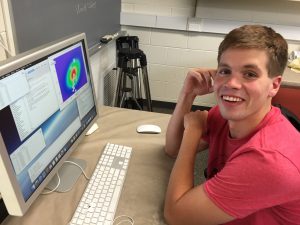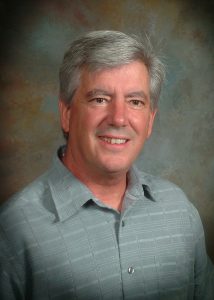Time travel, long imagined by writers and dreamers, is not as far-fetched as you might believe. Sure, it seems fantastical and improbable — the imaginings of which are only meant for postulations and movies — but astrophysicists do it all the time.

And so did Hope College freshman Jeff Engle in the summer of 2016 at NASA’s Goddard Space Flight Center in Greenbelt, Maryland. All it took was expensive, highly powered, one-of-a-kind stellar equipment called the Fermi Gamma-Ray Space Telescope. That and funding and guidance from the Hope College physics department and Professor Dr. Peter Gonthier.
Before ever taking one class at Hope, Engle spent his pre-freshmen summer as a member of the Hope physics department’s Research Bridge Program which operates with the belief that students should “learn physics by doing physics.”

Engle spent his pre-freshman summer in the physics department’s Research Bridge Program as part of the department’s philosophy that students should “learn physics by doing physics.” Before ever setting foot in his first Hope College class, Engle worked with two upperclassmen, Jesse Ickes ’16 and sophomore Josiah Brouwer, on pulsar star research with Gonthier at Goddard and at Hope.
Five incoming freshmen took part in the Bridge Research Program in 2016, and Dr. Stephen Remillard, chairperson of the department, hopes to expose as many 2017 freshmen to similarly strong laboratory experiences. “With the Physics Summer Bridge Program, incoming students who are seriously considering a career as a physicist have the opportunity to begin the real science that is one of the great pillars of a Hope College science education,” describes Remillard. “As they begin their first physics course, bridge students have already gained familiarity with the application of the knowledge. Ultimately, this undergraduate research will open doors for these students as they continue into industry, graduate programs, or wherever their scientific training takes them.”
Engle jumped into his first Hope research experience “kind of blindfolded because I’d never done anything like that before,” he admits. He found Gonthier and his fellow Hope students encouraging and supportive. “I was a little nervous because I was going to be working around well-known scientists (at Goddard).” But he embraced the experience nonetheless.
“Stars, such as pulsars, give off gamma and radio waves and these are filtered through the telescope which shows us the ways they were created billions of years ago,” says Gonthier. “Understanding pulsars helps us know more about our galactic center, about the beginning the universe.”
With Goddard’s Fermi (a cousin to the famed Hubble Telescope), Gonthier and crew were working with a virtual time machine. The telescope takes its users back in time and space to see the history of the entire universe written in the heavens beyond our sky. “Stars, such as pulsars, give off gamma and radio waves and these are filtered through the telescope which shows us the ways they were created billions of years ago,” says Gonthier. “Understanding pulsars helps us know more about our galactic center, about the beginning the universe.”

Gonthier has conducted research at Goddard for the past 24 summers, most years taking Hope students along with support from grant funding. His work in theoretical physics is helping to develop and test realistic descriptions of pulsars’ magnetospheres, important for the understanding of how neutron stars are able to produce radio and high-energy radiation pattern. His team worked last summer in the Goddard office of Nobel Laureate John Mather.
“It was definitely humbling to meet him and work in his office,” says Engle of cosmologist Mather, recipient of the 2006 Nobel Prize in physics for his work on the Cosmic Background Explorer Satellite with George Smoot.
“One of the best things about getting to do research at Goddard was being able to see the way so many people of different nationalities come together to study one thing — our universe,” Engle says. “There were scientists there from Africa, Russia, Italy, Greece, and the Netherlands. It was cool to get to work around them.”
Engle isn’t sure what kind of scientist he wants to be at this point, but he knows one thing for sure: This early experience has helped him appreciate not only all that goes into conducting such complicated research but all that goes into this complicated universe. Ultimately, it even helped strengthen his Christian faith.
“It is so cool to see how delicate the system is, how God is at work in it all.”
“If anything were different about our solar system, if anything was off just a little bit, it would be a huge mess,” says Engle. “It is so cool to see how delicate the system is, how God is at work in it all.”

